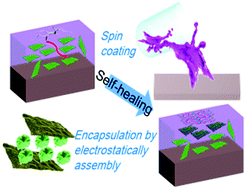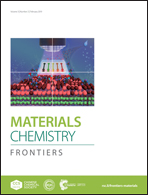Facile synthesis of intelligent nanocomposites as encapsulation for materials protection†
Abstract
Graphene grafted with polymers has exhibited a superior labyrinth effect. However, avoiding micro-galvanic corrosion is challenging if this material forms a conductive pathway with corrosive media. Although methods for preparing smart barrier-insulated graphene have been reported, the resulting synergistic flexibility and self-healing performance have yet to be studied. Herein, we have developed two strategies that use a layered double hydroxide to solidify poly(3,4-ethylenedioxythiophene) effectively. The synthesis and exfoliation of MgAl-LDH/PEDOT:PSS hybrid materials and their flocculation with reduced graphene oxide through charge-directed assembly are reported. The as-synthesized LDH/PEDOT:PSS@RGO hybrid materials showed lateral dimensions of hundreds to thousands of nanometres. Furthermore, the nanocomposites yielded a hybrid film through incorporation into polyvinylbutyral, with the coatings exhibiting significant corrosion resistance and avoiding micro-galvanic corrosion. These materials have a self-healing capability that responds to stimuli from the environment due to PEDOT:PSS undergoing ionic crosslinking. In brief, through simple synthesis, analysis of corrosion inhibition behaviour, and examination of interface adsorption, hybrid films with enhanced corrosion–resistance are reported as promising candidates for materials protection.



 Please wait while we load your content...
Please wait while we load your content...